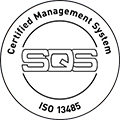Sleep apnoea is a respiratory disorder that can have a significant impact on health and quality of life. It is characterised by pauses in breathing or reductions in airflow during sleep. Understanding how to calculate the sleep apnoea index is essential for assessing the severity of the disorder and determining appropriate treatments.
Apnoea-hypopnoea index (AHI)
The diagnosis of sleep apnoea is based primarily on the apnoea-hypopnoea index (AHI). This index measures the number of episodes of apnoea (total cessation of breathing for at least 10 seconds) and hypopnoea (significant reduction in respiratory flow associated with a drop in oxygen saturation) per hour of sleep.
The AHI is calculated using a sleep study called polysomnography, an examination carried out by professionals in a sleep laboratory or at home. This examination measures several physiological parameters, including :
- Breathing flows.
- Oxygen levels in the blood.
- Thoracic and abdominal movements.
- Snoring.
- The sleeping position

Once the data have been collected, the AHI is calculated as follows:
AHI = (Total number of apnoeas + Total number of hypopnoeas) / Total sleep time in hours
Classification of sleep apnoea according to AHI
The AHI is used to classify the severity of sleep apnoea into three categories:
- Light apnea : AHI between 5 and 15.
- Symptoms are often limited to mild fatigue and snoring.
- Few serious health repercussions in the short term, but monitoring is recommended.
- Use of devices such as a nasal dilator (in the case of simple snoring) or sometimes a mandibular advancement orthosis or a positioning pillow or belts for positional treatment.
- Moderate apnea : AHI between 15 and 30.
- More pronounced symptoms: daytime sleepiness, headaches on waking and difficulty concentrating.
- Increased risk of cardiovascular disease.
- Severe apnea : AHI greater than 30.
- Significant health risks, including high blood pressure, stroke and diabetes.
- Intensive treatment is required, often including the use of a continuous positive airway pressure (CPAP) machine.
- Use of a continuous positive airway pressure (CPAP) device or a mandibular advancement orthosis. Possibly with complementary positional treatment.
In addition to polysomnography, there are portable devices for home assessment. These devices measure parameters such as respiratory flow, oxygen saturation and heart rate. Although less accurate than a laboratory study, they are useful and commonly used to screen for sleep apnoea.
Mobile applications and connected watches also offer sleep monitoring solutions. These practical, fun tools are no substitute for in-depth medical analysis. They can, however, provide useful indications to alert you to possible abnormalities.
The consequences of untreated sleep apnoea
Untreated sleep apnoea can lead to serious complications. These include :
- Cardiovascular problems : Sleep apnoea increases the risk of hypertension, heart failure and stroke.
- Metabolic disorders : The risk of type 2 diabetes is also increased.
- Cognitive decline : Sleep deprivation linked to apnoea can affect memory, concentration and decision-making.
- Accidents : Daytime sleepiness is a major risk factor in road accidents and accidents at work.
Why it is important to detect and assess sleep apnoea
Early identification of sleep apnoea is crucial in preventing long-term complications. People suffering from this disorder have a high risk of developing serious health problems, including cardiovascular disease, depression and a reduced overall quality of life.
Appropriate treatment for sleep apnoea can reduce or eliminate symptoms, making nights more restful and days more enjoyable.

When to consult a specialist
If you are experiencing symptoms such as loud snoring, excessive fatigue during the day or breathing pauses observed by someone close to you, it is essential to consult a sleep specialist. He or she will be able to prescribe the necessary tests to confirm the diagnosis and assess the severity of the disorder.
Doctors can also refer you to appropriate solutions, such as CPAP devices, mandibular advancement orthoses or positional apnoea treatment.
Prevention and sleep hygiene
Adopting good sleep hygiene can help reduce mild to moderate symptoms of sleep apnoea. Here are a few tips:
- Maintaining a healthy weight: Excess weight is a major risk factor. Weight loss can significantly reduce the AHI.
- Sleeping on your side: Sleeping on your back can make apnoea worse. Using devices such as pillows or belts to maintain this position can be helpful.
- Avoid alcohol and sedatives: These substances relax the muscles of the airways, increasing the risk of obstruction.
- Creating an environment conducive to sleep: A quiet, dark and cool bedroom is the best way to get a good night's sleep.
In conclusion, the measurement of sleep apnoea is a process based on the analysis of AHI, a key indicator for diagnosing and classifying this disorder. By understanding the different categories of apnoea (mild, moderate and severe) and recognising the symptoms, it is possible to act quickly to improve the health and quality of life of those affected.
In addition, preventive measures and a healthy lifestyle are essential allies in reducing the risks associated with sleep apnoea. If you suspect this disorder, don't delay in consulting a professional for a diagnosis and appropriate treatment.


